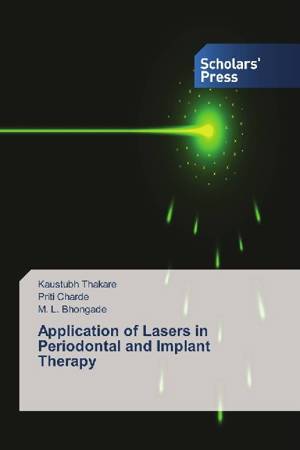
Je cadeautjes zeker op tijd in huis hebben voor de feestdagen? Kom langs in onze winkels en vind het perfecte geschenk!
- Afhalen na 1 uur in een winkel met voorraad
- Gratis thuislevering in België vanaf € 30
- Ruim aanbod met 7 miljoen producten
Je cadeautjes zeker op tijd in huis hebben voor de feestdagen? Kom langs in onze winkels en vind het perfecte geschenk!
- Afhalen na 1 uur in een winkel met voorraad
- Gratis thuislevering in België vanaf € 30
- Ruim aanbod met 7 miljoen producten
Zoeken
Application of Lasers in Periodontal and Implant Therapy
Kaustubh Thakare, Priti Charde, M. L. Bhongade
Paperback | Engels
€ 59,45
+ 118 punten
Omschrijving
The development of the use of lasers in dentistry has grown in the last 5 to 6 years and suddenly, many clinicians began looking to replace their aging electrosurgery units. Nd:YAG and carbon dioxide (CO2) lasers were the first soft tissue laser wavelengths introduced in dentistry in the early 1990s. Diode lasers, first introduced in 1995 for soft-tissue procedures, have impacted many areas of our dental practice . The erbium family of hard-tissue lasers (Er,Cr:YSGG and Er:YAG wavelengths) made their appearance in dentistry in the late 1990s and were heralded initially for their ability to cut tooth structure as well as soft tissue. The ability to ablate anything with water in it made it possible to use these "all tissue" lasers for many purposes. Lasers may be a novel, effective tool for the treatment of periodontitis. However, lasers have advantages as well as disadvantages. Therefore the operator must be aware of the possible risks involved in clinical applications, and precaution must be exercised to minimize these risks when performing laser therapy.
Specificaties
Betrokkenen
- Auteur(s):
- Uitgeverij:
Inhoud
- Aantal bladzijden:
- 116
- Taal:
- Engels
Eigenschappen
- Productcode (EAN):
- 9783330650510
- Uitvoering:
- Paperback
- Afmetingen:
- 150 mm x 220 mm

Alleen bij Standaard Boekhandel
+ 118 punten op je klantenkaart van Standaard Boekhandel
Beoordelingen
We publiceren alleen reviews die voldoen aan de voorwaarden voor reviews. Bekijk onze voorwaarden voor reviews.









